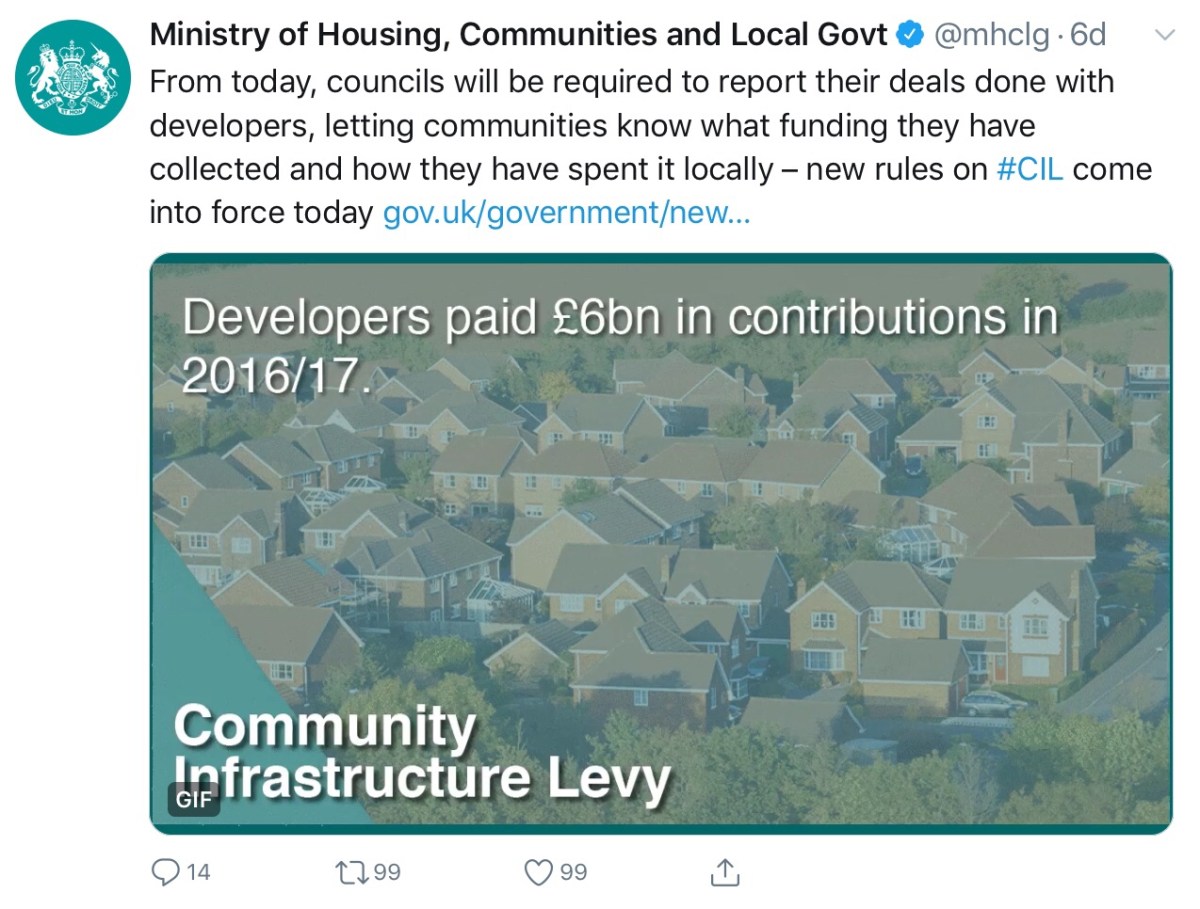There appears to be a new domestic political urgency about climate change (to the extent that there is space for anything other than the B word). After saying as little as possible about the politics, the focus of this blog post is on law, and specifically, climate change litigation, although as can be the case with some constitutional law cases (not to mention judicial reviews in our little Planning Court world), climate change law is an area where the purpose of the proceedings, succeed or fail, is often simply to change the politics.
The politics
Party members backed a radical “Green New Deal” motion at last week’s Labour party conference Labour set to commit to net zero emissions by 2030 (Guardian, 24 September 2019). If that is to form part of the next manifesto, some serious thinking is going to be required as to how to turn headlines into costed, politically and socially acceptable reality, but the starting gun has perhaps been fired.
Ahead of the Conservative party conference this week, as I write this morning we are waiting for a series of Government announcements, trailed overnight in pieces such as ‘21st Century Conservatism’: Tories unveil fresh wave of net zero measures (Business Green, 28 September 2019) and Tories ignore tough climate change recommendations in 2050 net zero plan, but promise nuclear fusion instead (Independent, 28 September 2019), which follows Theresa May’s June 2019 tightening of the minimum 80% reduction against 1990 levels figure in the Climate Change Act 2008 Act to 100% ie net zero greenhouse emissions by 2050, with an announcement on 12 June 2019 and the making of the Climate Change Act 2008 (2050 Target Amendment) Order 2019 on 26 June 2019. The amended target excluded international aviation and shipping pending further analysis and international engagement. The Committee on Climate Change on 24 September 2019 published advice to the Secretary of State for Transport as to how emissions from these sectors could be brought within the 2050 target.
UN
It was of course also the UN Climate Action Summit last week, with a series of actions announced, trackable via this detailed portal.
Convention on the Rights of the Child petition
Greta Thunberg announced at the UN that proceedings were being brought under the UN Convention on the Rights of the Child against Argentina, Brazil, France, Germany and Turkey, as G20 countries which are alleged not to have kept previously made pledges in international climate change conventions and agreements. The detailed petition (96 pages of reasoned argument, with evidence) to the Committee on the Rights of the Child (which monitors states’ compliance with the Convention) alleges that:
⁃ “each respondent has failed to prevent foreseeable human rights harms caused by climate change by reducing its emissions at the “highest possible ambition.” Each respondent is delaying the steep cuts in carbon emissions needed to protect the lives and welfare of children at home and abroad.”
⁃ “as members of the G20, which makes up 84% of all global emissions, each respondent has failed to use all available legal, diplomatic, and economic means to protect children from the life-threatening carbon pollution of the major emitters (China, the U.S., the E.U., and India) and other G20 members. As G20 members, the respondents have diplomatic, legal, and economic tools at their disposal. Yet, none of the respondents have used, much less exhausted, all reasonable measures to protect children’s rights from the major emitters”.
“By recklessly causing and perpetuating life-threatening climate change, the respondents have failed to take necessary preventive and precautionary measures to respect, protect, and fulfill the petitioners’ rights to life (Article 6), health (Article 24), and culture (Article 30) and are thus violating the Convention. Under the Convention, states must “limit ongoing and future damage” to these rights, including those caused by environmental threats.”
The five states were selected as the five largest emitters of carbon that are signatories to the Convention. China, USA, Saudi Arabia and Russia are not signatories.
Obviously, steps like these are taken for a variety of motives – direct legal redress is unlikely, but it all adds to the political pressure and of course shines a more direct light publicly on the relevant issues. It also made me realise that I should perhaps write this follow up to my 10 August 2019 climate change blog post The Big CC (which, I’m sorry, was a bit of a monster) to reference some of the other climate change litigation that we have been seeing.
Heathrow
The appeals from the Heathrow court rulings that I summarised in my 4 May 2019 blog post Lessons From The Heathrow Cases will be heard by the Court of Appeal on 17, 18, 22, 23, 24 & 25 October 2019. They will be live streamed.
Whilst the attacks by the various claimants to the Secretary of State’s decision to designate the Airports National Policy Statement were wide-ranging, challenges brought by Plan B Earth and Friends of the Earth focused on climate change arguments.
Plan B Earth sought to establish that “government policy” to be taken into account in designating the NPS included a commitment to the Paris Agreement limit in temperature rise to 1.5oC and “well below” 2oC. The Secretary of State acted unlawfully in not taking into account that commitment; and in taking into account an immaterial consideration, namely the global temperature limit by 2050 of 2oC above the pre-industrial level which, by the time of the designation, had been scientifically discredited as recognised by the UK Government as a party to the Paris Agreement and other announcements of support for the 1.5oC limit upon which the Paris Agreement was based (Plan B Earth Ground 1).”
However, the Divisional Court held that “the Secretary of State was not obliged to have foreshadowed a future decision as to the domestic implementation of the Paris Agreement by way of a change to the criteria set out in the CCA 2008 which can only be made through the statutory process; and, indeed, he may have been open to challenge if he had proceeded on a basis inconsistent with the current statutory criteria. Nor was he otherwise obliged to have taken into account the Paris Agreement limits or the evolving knowledge and analysis of climate change that resulted in that Agreement.”
Plan B Earth also sought to argue that the “Secretary of State erred and failed to act in accordance with section 3 of the Human Rights Act 1998, which requires legislation to be read and given effect in a way which is compatible with the ECHR rights, by failing to read and give effect to the phrase in section 5(8) of the PA 2008, “Government policy relating to the mitigation of, and adaptation to, climate change”, as including the Paris Agreement” and that “in any event, irrespective of the terms of the PA 2008, the Secretary of State acted irrationally in taking into account the discredited 2oC limit and not taking into account the 1.5oC limit to which, by the time of the designation, the Government was committed.” Both grounds were also rejected.
Friends of the Earth argued, unsuccessfully, that the NPS did not adequately explain how the 2050 carbon target as set out in section 1 of the Climate Change Act 2008 had been taken into account and /or that in a number of respects the NPS was “internally contradictory or otherwise unclear” as to its compatibility with the 2050 emissions target.
They also argued that section 10 of the Climate Change Act 2008 “requires the Secretary of State, on the basis of up to date information and analysis, to take into account the ability of future generations to meet their needs, which includes taking into account international agreements such as the Paris Agreement and the underlying science of climate change which bear upon that question.” However, the court held that “international commitments were a consideration in respect of which he had a discretion as to whether he took them into account or not.
It is well-established that where a decision-maker has a discretion as to whether to take into account a particular consideration, a decision not to take it into account is challengeable only on conventional public law grounds. In our view, given the statutory scheme in the CCA 2008 and the work that was being done on if and how to amend the domestic law to take into account the Paris Agreement, the Secretary of State did not arguably act unlawfully in not taking into account that Agreement when preferring the NWR Scheme and in designating the ANPS as he did. As we have described, if scientific circumstances change, it is open to him to review the ANPS; and, in any event, at the DCO stage this issue will be re-visited on the basis of the then up to date scientific position.”
Lastly, Friends of the Earth argued unsuccessfully that the obligations of the Paris Agreement should have been taken into account in the environmental report that was prepared for the purposes of the strategic environmental assessment that informed the Secretary of State’s decision to designate the NPS.
Generally, the passages in the judgment in relation to climate change (paragraphs 558 to 660) are well worth reading. Will the Court of Appeal hold to the same line?
Plan B Earth “carbon target” litigation
Plan B Earth had previously brought a challenge to the Secretary of State’s refusal to revise the 2050 carbon target under the 2008 Act, on the basis that he was obliged to do so following the Paris Agreement.
The proceedings, Plan B Earth v Secretary of State (Supperstone J, 20 July 2018), were dismissed as unarguable.
One of the grounds of challenge was that the Secretary of State’s refusal to amend the 2050 target constitutes a violation of the claimants’ human rights. “The Claimants rely on the rights conferred by Articles 2 and 8 of the ECHR, and by Article 1 of the First Protocol, both individually and in conjunction with Article 14. Mr Crow submits that in so far as the Secretary of State is acting inconsistently with his Treaty obligations and with general principles of international law, he is in breach of his positive obligations to uphold the Claimants’ Convention rights. This ground, Mr Crow acknowledges, raises a novel issue under the HRA 1998. However he observes that it is difficult to conceive of any issue that would be of greater significance to each member of the British public than the threat of climate change, which the Government has acknowledged as constituting an “existential threat”. In this context, he submits that the Government’s delay is inexcusable (Ground 4).
Mr Palmer submits that the decision not to amend the 2050 target at this time does not amount to an interference with any identifiable victim’s rights under any of the Articles relied upon. Mr Crow accepts there is no interference with any identifiable victim’s rights, but submits that there has been a violation of those rights, which have an environmental dimension. The Claimants do not identify any interference to which that decision gives rise, but only to the effects of climate change generally. The violation arises, it is said, because of the failure of the Secretary of State to take proper preventive measures. I reject this submission. The Government is committed to set a net zero emission target at the appropriate time. I agree with Mr Palmer that this is an area where the executive has a wide discretion to assess the advantages and disadvantages of any particular course of action, not only domestically but as part of an evolving international discussion. The Secretary of State has decided, having had regard to the advice of the Committee, that now is not the time to revise the 2050 carbon target. That decision is not arguably unlawful, and accordingly the human rights challenge is not sustainable.”
Permission to appeal was refused by the Court of Appeal on 22 January 2019.
Urgenda
It is interesting to contrast these two rulings with the Dutch proceedings brought by campaign group, Urgenda. As summarised by the LSE/Grantham Research Institute on Climate Change and the Environment, the Hague Court of Appeal ruled (unofficial English translation, 9 October 2018) “that by failing to reduce greenhouse gas emissions by at least 25% by end-2020, the Dutch government is acting unlawfully in contravention of its duty of care under Articles 2 and 8 of the ECHR. The court recognized Urgenda’s claim under Article 2 of the ECHR, which protects a right to life, and Article 8 of the ECHR, which protects the right to private life, family life, home, and correspondence. The court determined that the Dutch government has an obligation under the ECHR to protect these rights from the real threat of climate change. The court rejected the government’s argument that the lower court decision constitutes “an order to create legislation” or violation of trias politica and the role of courts under the Dutch constitution. In response to these appeals, the court affirms its obligation to apply provisions with direct effect of treaties to which the Netherlands is party, including Articles 2 and 8 of the ECHR. Further, the court found nothing in Article 193 of the Treaty on the Functioning of the European Union that prohibits a member state from taking more ambitious climate action than the E.U. as a whole, nor that adaptation measures can compensate for the government’s duty of care to mitigate greenhouse gas emissions, nor that the global nature of the problem excuses the Dutch government from action.”
An appeal was heard by the Dutch Supreme Court in May 2019 and its ruling is anticipated before the end of the year.
The end of the year? I think they need a Lady Hale.
Simon Ricketts, 28 September 2019
Personal views, et cetera






